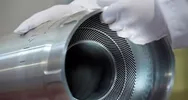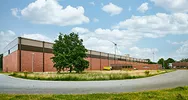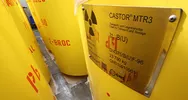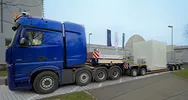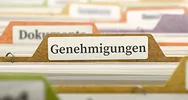Approximately 6.9 kg of uranium remains in a spent fuel element, roughly 6 kg of which is uranium-235. Additionally, it contains about 12 g of plutonium. The enrichment level of the spent fuel elements – how much uranium is uranium-235 – ends up at roughly 88 %, compared to the 93% of fresh fuel elements. The gross mass of a spent fuel element is about 44kg, most of which is aluminium.
FRM II has the highest ratio of usable neutron flux to thermal power worldwide, making it particularly resource-efficient. The high neutron density in the neutron flux is a prerequisite for the highly specialised research conducted at the FRM II and thus for the strong international position of German neutron research.
The decision to use a high-flux neutron source inevitably meant using HEU (highly-enriched uranium). However, even before FRM II was planned and built, starting in the late 1970s, there was an international political effort to limit the use of HEU in research reactors as much as possible. This is not due to safety concerns; HEU is not inherently more dangerous than LEU (low-enriched uranium), and the necessary precautions are also ensured in HEU reactors.
Further information on conversion.
Globally, more than 70 reactors have converted until now. Two reactors have successfully been converted to LEU in Germany: BER 2 (1997 – 2000) and DIDO (2004). Both of them are out of operation as of 2022.
To this day, no high-performance research neutron source has been successfully converted.
The following high-performance research reactors and neutron sources are in operation with HEU globally:
| Name | Reactor Type | Country | First Criticality | Therm. Power | Fuel | Enrichment |
| FRM II | Beam Tube | Germany | 2004 | 20 MW | U3Si2/Al | 93% |
| RHF | Beam Tube | France | 1971 | 58,3 MW | UAlx/Al | 93% |
| BR2 | MTR* | Belgium | 1961 | 100 MW | UAlx/Al | 93% |
| MITR | Beam Tube | USA | 1958 | 6 MW | UAlx/Al | 93% |
| NBSR | Beam Tube | USA | 1967 | 20 MW | UO2/Al | 93% |
| MURR | Beam Tube | USA | 1966 | 10 MW | UAlx/Al | 93% |
| ATR | MTR | USA | 1967 | 250 MW | UAlx/Al | 93% |
| HFIR | Beam Tube | USA | 1965 | 100 MW | U3O8/Al | 93% |
*) Material Testing Reactor
Further information on conversion.
The Ahaus Interim Storage Facility is intended to store fuel elements from German research reactors. In 1993, the city of Ahaus agreed to an amendment to the settlement agreement, according to which fuel elements from research reactors can be stored in the Ahaus interim storage facility, provided that a nuclear licence is granted for this purpose.
On this basis, the then operator of the interim storage facility agreed with TUM in 2000 for the future storage of up to 21 casks at the Ahaus interim storage facility.
By storing the FRM II fuel elements in the Ahaus interim storage facility, BGZ Gesellschaft für Zwischenlagerung mbH is fulfilling this contractual obligation. This is a prerequisite for the neutron source to continue supplying neutrons for scientific purposes in the future, thereby making an essential contribution to solving fundamental scientific questions.
The distribution of nuclear waste among interim storage sites is based on contractual obligations and political agreements.
In 1993, the city of Ahaus and the former operator of the interim storage facility agreed that fuel elements from research reactors could be stored at the interim storage facility, provided that a nuclear licence was granted.
As a result of these agreements, the third partial licence for FRM II stipulated that the spent fuel elements would be transferred to the Ahaus interim storage facility. For this reason, an agreement on future storage was concluded in 2000 between the Free State of Bavaria, represented by the Technical University of Munich, and Brennelement-Zwischenlager Ahaus GmbH. This disposal route is now being consistently pursued.
The distribution of HAW waste (HAW: highly active waste) from reprocessing to the Brokdorf, Biblis, Philippsburg and Isar interim storage facilities was decided in 2015 by broad political consensus between the Federal Government and all the state governments involved.
For this reason, the Isar interim storage facility is intended, among other things, for the HAW waste to be returned from reprocessing at Sellafield in the UK.
The federal and state governments welcomed the agreement as a fair regional burden distribution.
The operating licence for the interim storage facility in Ahaus expires in 2036. The planned final repository in Germany is not expected to operate before 2051.
Therefore, the storage licence for the fuel elements of FRM II is linked to the operating licence for the interim storage facility and is not perpetual.
As the final repository for high-level radioactive waste is scheduled to commence operation in the middle of this century in accordance with the National Waste Management Programme, BGZ Gesellschaft für Zwischenlagerung mbH is already preparing to demonstrate the safety of interim storage beyond 40 years in nuclear licensing procedures with public participation and to have it reviewed in accordance with the current state of science and technology.
At FRM II, the fuel element heads (approx. 42 cm long aluminium pieces used to handle the fuel elements) are cut off before the fuel elements are packed into the transport and storage casks. This serves to reduce volume and optimise waste separation. The pure aluminium pieces are stored as medium-level radioactive waste in an appropriate final repository.
No further processing is necessary.
The Atomic Energy Act requires that the safe storage of irradiated nuclear fuel in interim storage facilities be ensured until it is delivered to a final repository. FRM II fulfils this obligation through the storage agreement concluded with the Ahaus Interim Storage Facility. Whether and to what extent conditioning is necessary before storage in a future final repository depends on the storage conditions for this final repository and is therefore not yet known.
Technically, the ‘processing’ of spent fuel elements corresponds to nuclear fuel reprocessing. Depletion is also a form of processing. According to the Atomic Energy Act (Section 7(1), sentence 2), such facilities are not eligible for approval in Germany and are therefore prohibited.
CASTOR® casks are transport and storage casks where spent fuel elements and highly radioactive materials can be safely packaged, transported and stored. They are developed and manufactured by the German company GNS and sold to customers worldwide. They are available in different designs, which are specifically adapted to the properties of the various fuel elements. The dimensions of the fuel elements vary depending on the type of reactor. However, the technical design of the casks is always the same.
CASTOR® casks are solid metal structures weighing several tonnes, which have been tested and proven to be safe even under extreme conditions. This is required for them to be granted official approval for use as transport and storage casks.
The casks are sealed with a double lid system that ensures the safe containment of the radioactive inventory at all times. The wall thickness of approximately 40 centimetres and the additional moderator material used ensure that the spent fuel elements in the casks do not pose a radiation hazard to the environment.
An MTR3 transport and storage cask is used for transport from Garching to Ahaus. The cask is around 1.6 metres high and has a diameter of approximately 1.5 metres. It can hold a maximum of five fuel elements from FRM II.
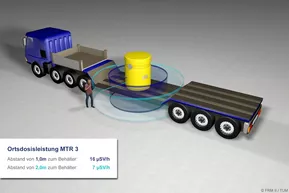
These data are the results of measurements of the so-called ambient dose rate (ADR) caused by the gamma and neutron radiation emitted by the individual loaded casks. The ADR indicates the dose received by an individual at a specific location over a particular period of time. Knowledge of the ADR is relevant for approving transports such as this one. The applicant must prove that an ADR of 100 microsieverts per hour (µSv/h) is not exceeded at a distance of two metres from the vertical outer surfaces of the transport vehicle. This is the legally prescribed limit for the transport of radioactive materials. The highest value calculated at this distance for the casks from Garching is 7 μSv/h ambient dose rate, which is less than one tenth of the permitted value.
The dose rate at the outer surface of the fully loaded MTR3 cask (in direct contact) is a maximum of 65 µSv/h.
• At a distance of 0.5 m from the cask, the ADR is 35 µSv/h.
• At a distance of 1 m from the cask, the ADR is 16 µSv/h.
• At a distance of 2 m from the cask, the ADR is 7 µSv/h.
For comparison: according to the Federal Office for Radiation Protection, 7 µSv/h corresponds approximately to the cosmic radiation to which one is exposed during one hour of flight at an altitude of 10,000 metres.
The parties involved have many years of experience loading, handling and transporting CASTOR® casks.
In addition, in preparation for transporting fuel elements from Garching to Ahaus, FRM II carried out a functional test of the CASTOR® MTR3 cask type to be used. Dummy fuel elements were used for the tests to simulate loading as realistically as possible. Each handling step with the cask was carried out by trained FRM II personnel.
The GNS Gesellschaft für Nuklear-Service mbH has been developing and manufacturing CASTOR® transport and storage casks for over 40 years. More than 1,500 of these safety casks have now been loaded and placed in interim storage. The casks must safely enclose the radioactive inventory, shield the radiation it emits and dissipate the heat generated inside. The casks have successfully completed extensive test programmes at the Federal Institute for Materials Research and Testing (BAM) and are approved for transport and storage in accordance with national regulations. They meet the high requirements of the International Atomic Energy Agency (IAEA) and the German Federal Office for the Safety of Nuclear Waste Management (BASE).
The casks are sealed with two lids. This double lid system guarantees the safe containment of the radioactive inventory. The tightness of the casks is continuously monitored during interim storage. The casks are designed to withstand even extreme impacts, such as transport accidents, fire or a plane crash. In accordance with the requirements of the International Atomic Energy Agency, CASTOR® casks must undergo various safety tests.
Further information on cask safety (GNS)
GNS developed the CASTOR® MTR3 on behalf of the three German research reactor operators, Technical University of Munich, Helmholtz Centre Berlin and Johannes Gutenberg University Mainz, to meet their current and future disposal requirements. The cask can be equipped with different support baskets for the various fuel element types of the three research reactors (TUM: KKE7; HZB: MTR; JGU: TRIGA)
A CASTOR® type MTR3, a cask specifically developed for fuel elements from research reactors, is used for each shipment. This type of cask can hold a maximum of five fuel elements. One cask is transported per shipment.
This means that 10 casks are required for the 48 spent fuel elements (as of August 2025) from Garching.
Orano NCS developed the transport vehicle in accordance with the transport licence. It will take the form of a truck with a semi-trailer. It is designed in accordance with the applicable SEWD guideline (‘Guideline for protection against interference or other third-party interference during the transport of nuclear fuels by road and rail’). For security reasons and so as not to compromise the effectiveness of these measures, further details cannot be disclosed.
TUM is not the applicant. The applicants are Gesellschaft für Nuklear-Service mbH (GNS) in the procedure for storage and transport casks; BGZ Gesellschaft für Zwischenlagerung mbH in the § 6 AtG procedure for storage approval; Orano NCS (formerly Daher NT) in the § 4 AtG procedure for transport approval. FRM II provides the applicants with the necessary documentation.
The licences build on each other as follows and are issued by the Federal Office for the Safety of Nuclear Waste Management (BASE):
1. Traffic law approval (German) of the CASTOR MTR 3 cask (approval granted by the BfE in January 2019)
The applicant in the approval process is the manufacturer of the casks, GNS. The reviewing authorities are the Federal Institute for Materials Research and Testing (BAM) in Berlin and the Federal Office for Nuclear Waste Management Safety (BfE) in Salzgitter. A report on the approval can be found here.
2. Storage Licence (§ 6 AtG) (German) (approval granted by BASE in August 2025)
BGZ, the operator of the Ahaus Interim Storage Facility, conducts the licensing procedure. The reviewing authorities are the Federal Office for the Safety of Nuclear Waste Management, the Federal Institute for Materials Testing and TÜV Hannover. The storage licence is a prerequisite for granting the transport licence (§ 4 AtG).
Further detailed information on the licensing procedure is available from the Federal Office for the Safety of Nuclear Waste Management (BASE). (German)
A report on the approval can be found here.
3. Transport Licence (§ 4 AtG) (German) (approval granted by BASE in August 2025)
The transport licence in accordance with Section 4 of the Atomic Energy Act was applied for by the transport company Daher NT (now Orano NCS), commissioned by FRM II, at the Federal Office for Nuclear Waste Management Safety (now BASE). The granting of the transport licence by the Federal Office for the Safety of Nuclear Waste Management (BASE) confirms the safe feasibility of the transport.
Further detailed information on the approval process is available from the Federal Office for the Safety of Nuclear Waste Management (BASE). (German)
A report on the approval can be found here.
On 25 August 2025, the Federal Office for the Safety of Nuclear Waste Management (BASE) granted storage authorisation (Section 6 AtG) for up to 21 CASTOR® MTR3 casks to BGZ Gesellschaft für Zwischenlagerung mbH and the transport licence (Section 4 AtG) initially for two CASTOR® MTR3 casks to Orano NCS GmbH.
